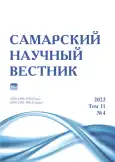Дистанционное изучение сезонной динамики вегетационного индекса (NDVI) растительного покрова массива Монгун-Тайга
- Авторы: Донгак Д.А.1, Монгуш А.В.1, Монгуш Ч.Б.1,2, Чулдум Ш.О.1
-
Учреждения:
- Центр биосферных исследований
- Центральный сибирский ботанический сад СО РАН
- Выпуск: Том 11, № 4 (2022)
- Страницы: 22-29
- Раздел: Биологические науки
- URL: https://journal-vniispk.ru/2309-4370/article/view/133212
- DOI: https://doi.org/10.55355/snv2022114103
- ID: 133212
Цитировать
Полный текст
Аннотация
В данной статье проведен анализ сезонной динамики растительного покрова массива Монгун-Тайга с февраля по октябрь 2022 г. на основе применения вегетационного индекса (ВИ, или NDVI) с использованием данных спутниковых снимков Sentinel-2. Для анализа сезонной динамики вегетационного индекса растительного покрова массива Монгун-Тайга были выбраны 15 точек на долинах пяти рек массива, таких как р. Толайты (южная сторона), р. Холаш (западная сторона), р. Балыктыг (северная сторона), р. Правый Мугур (северо-восточная сторона) и р. Шара-Хорагай (восточная сторона). Графики ВИ растительного покрова разных экспозиций склонов массива показывают, что максимальные значения представлены в точке западной стороны массива (р. Холаш), затем – на южной стороне (р. Толайты) и далее – северной стороне массива (р. Балыктыг). Самые низкие показатели ВИ растительного покрова имеют долины рек Шара-Хорагай (восточная сторона массива) и р. Правый Мугур (северо-восток массива). Различные кривые графиков ВИ растительного покрова по разным экспозициям массива объясняют, что климат в данном районе очень сложный, рельеф, экспозиции склонов, влажность, сила и направления ветров, солнечный свет, температура, уклоны выбранных точек для исследования, а также водотоки влияют на растительный покров неодинаково. Для более тщательного изучения необходимо получение снимков более высокого разрешения и проведение наземных измерительных работ по оценке состояния растительного покрова массива и получению точных метеорологических данных.
Полный текст
Открыть статью на сайте журналаОб авторах
Джамиль Айыр-Санааевич Донгак
Центр биосферных исследований
Email: jamildongak@yandex.ru
кандидат технических наук, начальник отдела научного сопровождения регионального развития
Россия, КызылАртыш Валерьевич Монгуш
Центр биосферных исследований
Email: artysh1003@gmail.com
главный специалист отдела научного сопровождения регионального развития
Россия, КызылЧинчи Буяновна Монгуш
Центр биосферных исследований; Центральный сибирский ботанический сад СО РАН
Автор, ответственный за переписку.
Email: chinchi96@mail.ru
главный специалист отдела научного сопровождения регионального развития, аспирант, ведущий инженер лаборатории микологии, альгологии и лихенологии
Россия, Кызыл; НовосибирскШыдар Орланович Чулдум
Центр биосферных исследований
Email: chuldum1997@mail.ru
главный специалист отдела научного сопровождения регионального развития
Россия, КызылСписок литературы
- Горный массив Монгун-Тайга / под ред. К.В. Чистякова. СПб.: Арт-Экспресс, 2012. 310 с.
- Москаленко И.Г., Селиверстов Ю.П., Чистяков К.Ю. Горный массив Монгун-Тайга (Внутренняя Азия) (Опыт эколого-географической характеристики). СПб., 1993. 94 с.
- Соболевская К.А. Растительность Тувы / отв. ред. В.В. Ревердатто. Новосибирск, 1950. 140 с.
- Маскаев Ю.М., Намзалов Б.Б., Седельников В.П. Геоботаническое районирование // Растительный покров и естественные кормовые угодья Тувинской АССР / отв. ред. И.Ю. Коропачинский. Новосибирск: Наука, 1985. С. 210–247.
- Седельников В.П. Высокогорная растительность Алтае-Саянской горной области. Новосибирск: Наука. Сиб. отд-ние, 1988. 223 с.
- Дирксен В.Г., Смирнова М.А. Характеристика растительности северного макросклона высокогорного массива Монгун-Тайга (Юго-Западная Тува) // Ботанический журнал. 1997. Т. 82, № 10. С. 120–131.
- Носин В.А. Почвы Тувы. М.: Изд-во Акад. наук СССР, 1963. 342 с.
- Федотова Е.В., Жолудев А.А., Изосимов В.Г., Шпирук Ю.Д., Маглинец Ю.А., Цибульский Г.М. Анализ сезонной динамики растительного покрова на основе данных дистанционного зондирования Земли // Журнал Сибирского федерального университета. Серия: Техника и технологии. 2014. Т. 7, № 8. С. 976–983.
- Цветкова А.А., Марков Д.С. Оценка экологического состояния биотопов Ивановской области на основе расчета NDVI // Успехи современного естествознания. 2011. № 7. С. 34–35.
- Мунзер Н. Разработка методики применения данных космических съемок для мониторинга лесов: автореф. дис. … канд. тех. наук: 25.00.34. М., 2021. 24 с.
- Замалитдинова М.Г., Ткачева И.П., Ергалиев Д.С., Сейткожина А.С. Исследование изменения растительности в зоне Аральского моря на основе космических снимков с использованием вегетационного индекса NDVI // Вестник Евразийского национального университета имени Л.Н. Гумилева. Серия: Технические науки и технологии. 2019. № 3 (128). С. 32–38.
- Соколова Г.Г. Влияние высоты местности, экспозиции и крутизны склона на особенности пространственного распределения растений // Acta Biologica Sibirica. 2016. Т. 2, № 3. С. 34–45.
- Суворова Г.Г., Попова Е.В. Фотосинтетическая продуктивность хвойных древостоев Иркутской области / отв. ред. Р.К. Саляев. Новосибирск: Академическое изд-во «Гео», 2015. 95 с.
- Adamovich T.A., Kantor G.Ya., Ashikhmina T.Ya., Savinykh V.P. The analysis of seasonal and long-term dynamics of the vegetative NDVI index in the territory of the State Nature Reserve «Nurgush» // Theoretical and Applied Ecology. 2018. № 1. P. 18–24.
Дополнительные файлы












